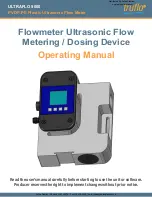
3. OPERATION
Page 59
© 2009 DH Instruments, a Fluke Company
Note
There is no reason to edit P
offset
during normal RPM4-E-DWT operation or
maintenance. P
offset
should only be adjusted using [AutoZ] (see Section
3.7.10).
3.9.2
<2REMOTE>
PURPOSE
To configure the RPM4-E-DWT COM1 and COM2 communication ports. To test COM1 and
COM2 communications. To select the remote programming communications format.
PRINCIPLE
The RPM4-E-DWT has two RS-232 communications ports referred to as COM1 and COM2.
COM1 is for communicating with a host computer (see Section 4), and COM2 is reserved for
communicating with an external device (e.g. an RPM4-E-DWTx, a multimeter, etc.). The
ports’ settings can be viewed and changed using
[SPECIAL]
,
<2remote>
.
RPM4-E-DWT has two remote communications formats, classic and enhanced (see Section
4.3). The active format can be selected.
A self test is supplied for RS-232 communications. The self test allows verification that the
RPM4-E-DWT RS232 ports (COM1 and COM2) are operating properly and that a valid
interface cable is being used.
OPERATION
To access the communications settings, press
[SPECIAL]
,
<2Remote>
.
•
Select
<1COM1>
to view and edit COM1 settings (see Section 3.9.2.1).
•
Select
<2COM2>
to view and edit COM2 settings (see Section 3.9.2.1.).
•
Select
<4format>
to select the remote communications command format (see Section
3.9.2.3).
•
Select
<5RS232test>
to run the COM1 and COM2 communications test (see Section
3.9.2.4).
3.9.2.1 <1COM1, 2COM2>
The COMx ports can be set for specific communications settings. The settings
are baud rate, parity, data bits and stop bits. The available options are:
Baud
300, 600, 1 200, 2 400, 4 800, 9 600, 19 200, 28 800, 38 400
Parity
NONE, ODD or EVEN
Length
7 or 8
Stop Bit
1 or 2
The default is <2 400, E, 7,1> for both COM1 and COM2.
The user can also specify one or two termination characters, referred to as
“Term1” and “Term2”, as well as define these characters. These define the
characters that mark the end of commands that are sent to the RPM4-E-DWT as
well as mark the end of replies sent back to the host computer. The
RPM4-E-DWT typically uses the
<Term1>
character to mark the end, and will
ignore the
<Term2>
character. The characters can be any decimal number from
1 to 255. The defaults are
<13>
(carriage return) and
<10>
(line feed) and
usually should not be changed.
Содержание E-DWT-H
Страница 6: ...E DWT H OPERATION AND MAINTENANCE MANUAL 2009 DH Instruments a Fluke Company Page IV Notes...
Страница 10: ...E DWT H OPERATION AND MAINTENANCE MANUAL 2009 DH Instruments a Fluke Company Page VIII Notes...
Страница 82: ...E DWT H OPERATION AND MAINTENANCE MANUAL 2009 DH Instruments a Fluke Company Page 72 Notes...
Страница 120: ...E DWT H OPERATION AND MAINTENANCE MANUAL 2009 DH Instruments a Fluke Company Page 110 Notes...
Страница 122: ...E DWT H OPERATION AND MAINTENANCE MANUAL 2009 DH Instruments a Fluke Company Page 112 Notes...
Страница 124: ...E DWT H OPERATION AND MAINTENANCE MANUAL 2009 DH Instruments a Fluke Company Page 114 Notes...
















































